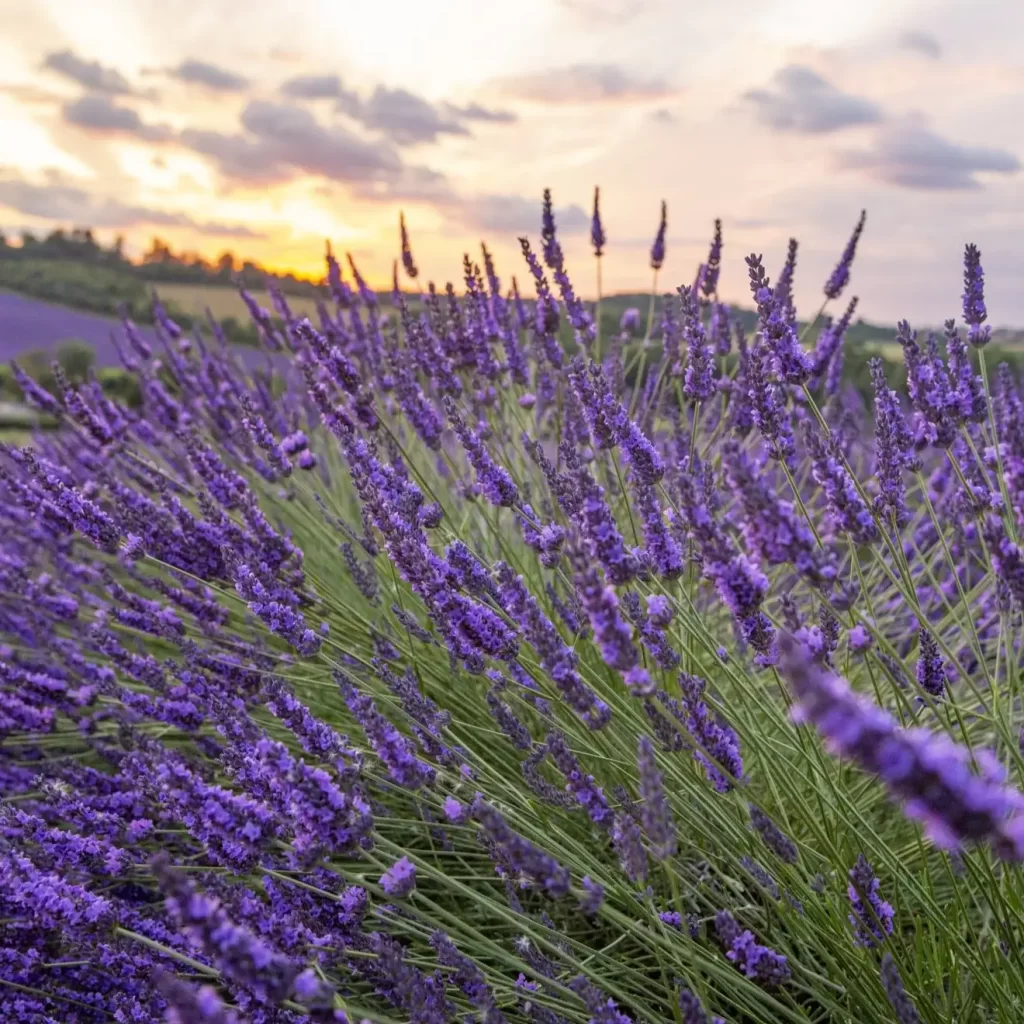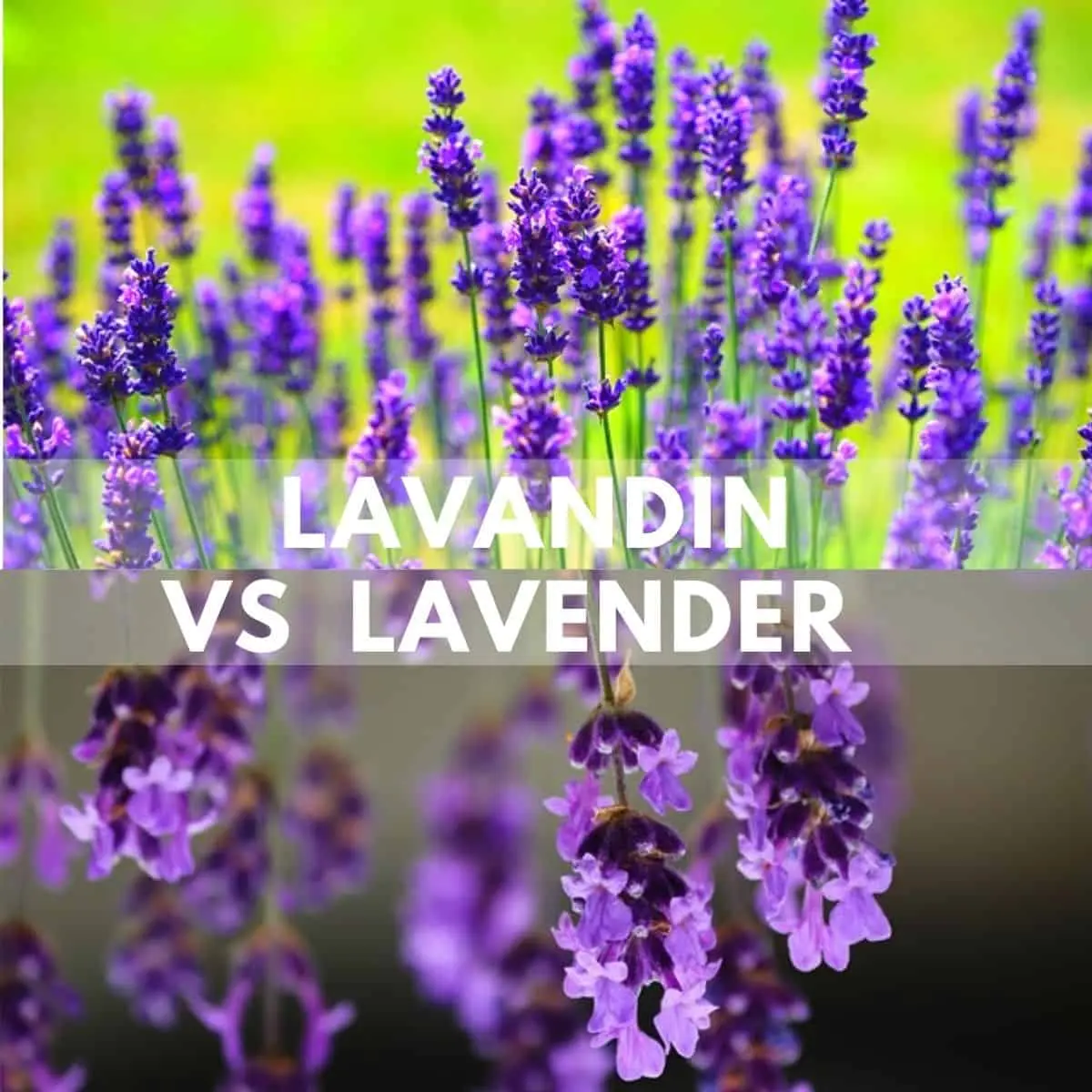There are two purple floral beauties out in the gardens that are busy filling the air with their sweet aromatic scents: Lavandin vs Lavender. You might have some interaction with these names while searching through your favorite essential oils or skincare products. But what’s the real difference between these lilac flowers?
In the world of botanicals, Lavender and Lavandin are two buds that often get mistaken for each other. To know in-depth join me as we get on a fascinating article to uncover the mysteries and differences between Lavender and Lavandin.

Difference Between Lavender And Lavandin
Lavender and Lavandin, while both being aromatic plants from the same family, have distinct differences that set them apart. Well, True lavender typically grows in a more compact and rounded shape, with narrow greyish leaves. In contrast, the Lavandin plant has broader silvery green leaves.
If we talk about the flower shape the heads of true lavender are light to medium purple, smaller, and tightly clustered together, which makes a spike-like shape at the top of the stems. Lavandin, however, has larger and more open flowers, with a looser cluster of blooms that are dark purple or bluish.
Let’s move to the stems of the lavender which are thinner and more delicate than those of Lavandin, with a woody texture and a grayish-brown color. The stems of true lavender also tend to be more branched, with a more complex structure that can sometimes form a small bush or shrub.
If you want some easy distinction then simply look at the length of both shrubs, Lvadin is longer in length in comparison to lavender.
Watch this video for a better understanding of how Lavadin vs Lanverder differs:
Lavandin vs Lavender: Botanical Classification
Lavender and lavandin both belong to the mint family, known as Lamiaceae. It also includes peppermint, rosemary, basil, and thyme. One thing they all share is square stems.
There are around 20 to 40 species of lavender, mostly found in the Mediterranean and the Middle East. The specific genus we are focusing on is Lavandula, which includes all types of lavender.
Lavandin came about naturally when insects carried pollen from higher-altitude True Lavender plants to lower-altitude Spike Lavender plants. Lavandin tends to have longer stems and more spike-shaped flowers compared to True Lavender, and its scent is stronger and more herbal.

Lavandin vs Lavender: Essential Oil Differenece
Lavender and Lavandin essential oils may seem similar, but they actually have unique traits because of their different chemical makeup.
Lavender Essential Oil
Lavender Essential Oil, from Lavandula angustifolia, is famous for its calming scent. It’s great for relaxation, whether in a diffuser at bedtime or applied to the skin for minor burns or bug bites.
Lavandin Essential Oil
Lavandin Essential Oil, from Lavandula x intermedia, is a bit different. It’s cheaper to produce because it gives more oil per plant. You’ll find it in a lot of household products like soap and air fresheners. It has a stronger smell and can repel bugs, but it’s not as gentle on the skin because it has more camphor, a strong-smelling compound.
Camphor Content
Lavandin oil has more camphor than Lavender oil, which gives it that strong, medicinal smell. It’s great for clearing your sinuses or keeping bugs away, but it’s not recommended for cuts or burns because it can irritate the skin.

The Different Types of Lavender Plants
Lavender is a beautiful and versatile plant that comes in various colors like blue, purple, white, and pink. There are five main types, but they’ve been mixed and matched to create over 40 other varieties. Each type has its own perks, so finding the right one for your garden or space might take some thinking. Let’s take a look at some popular ones:
1. English Lavender (Lavandula angustifolia)
This type is super common, with tall stems covered in tiny blue flowers. It loves colder weather and keeps coming back year after year.
2. French Lavender (Lavandula stoechas)
French Lavender stands out with its pinkish-purple bracts. It needs lots of sunlight and warmth to thrive.
3. Portuguese Lavender (Lavandula latifolia)
This one is really aromatic and has dark purple flowers. It’s tough and hardy, perfect for gardens.
4. Lavandin (Lavandula x intermedia)
Lavandin is a mix of two other lavenders, so it’s bigger and stronger. Its flowers are larger and its stems are longer.
5. Fernleaf Lavender (Lavandula multifida)
Fernleaf Lavender has delicate, fern-like leaves and small purple-blue flowers. It’s not as common but it smells great.
Lifespan of Lamiaceae family
The mint family, also known as Lamiaceae, is a big plant family with lots of different types Lavender is one of it. Some are small herbs that only live for a short time, while others are big trees that stick around for years.
Most of these plants are either perennial (they live for more than two years) or annual (they live for less than one year), but some are woody shrubs or subshrubs that can live a long time. For example, there are even trees in this family, like Teak.
Also, don’t miss reading on tips to reduce moving expenses in New York.
English Lavender and Lavandin have some clear differences. Lavandin plants are usually bigger, with longer and larger flower spikes compared to English Lavender. They also have smaller spikes growing from the sides of the stem.
Lavandin is a mix of English Lavender and Portuguese Lavender, which gives it traits from both parents.
Lavender grows slowly and needs lots of care, while Lavandin grows faster and is tougher against pests and diseases. Lavender takes a while to reach its full size, but Lavandin grows quickly and can get big in just a few years.
Choosing the best Lavender Essential Oil depends on what you need and like. Some people recommend Eden’s Garden Pure Therapeutic Lavender Oil for its quality.
Wrapping Up
We have been through the interesting breakdown of Lavandin vs Lavender, physical appearance, essential oil extracted from them, and a lot more. Understanding these differences is crucial for their identification, cultivation, and usage. So, next time you see Lavender or Lavandin, you’ll appreciate what makes each of them special.

